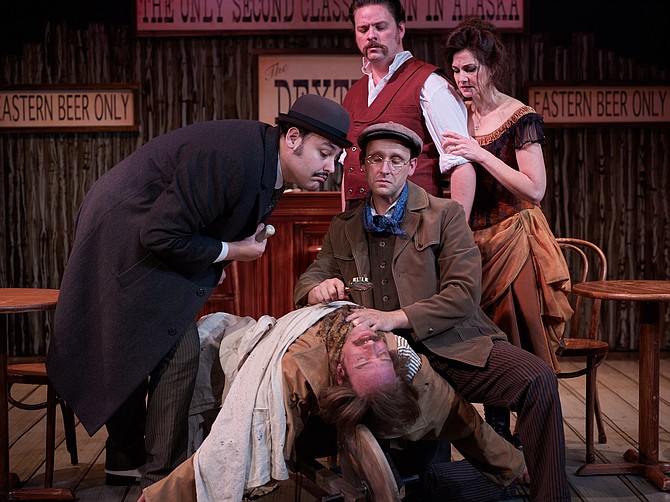 Facebook
Facebook
 X
X
 Instagram
Instagram
 TikTok
TikTok
 Youtube
Youtube

When a card game in London turns deadly, Sherlock Holmes follows the one clue that will save his client from the gallows — a land deed — all the way to Alaska.
But at the height of the gold rush, when land is as good as gold, he’s not the only one on the trail. Will he out-sleuth gunslingers, unscrupulous lawmen, and a widow hellbent on claiming what’s rightfully hers before it’s too late?
Joseph Vass’s world premiere is a whodunit complete with kangaroo court, highjinks, and musical numbers. And it works, for the most part.
Holmes (Jason Maddy), posing as a traveling Irish violinist, lands a gig at Wyatt Earp’s famed Dexter Saloon and dives into the local drama.
Charlotte (Katie Karel), the landowner’s widow, must stop a businessman (Andrew Barnicle) from stealing the claim. Opportunistic schemer Ace (Louis Lotorto) hopes to trump them all and find the missing deed by any means necessary. Everyone has a motive for deception, and distinguishing the virtuous from the villainous is a task.
The script calls for a large cast, so it makes sense that the actors play multiple roles. Yet, for a saga as meticulous as it is deceiving, it’s risky to interchange the actor playing the central villain with anyone, especially when disguise is used as a plot element.
I don’t fault the actor’s character choices. They were distinct. But they were confusing to me and the woman sitting next to me (who leaned over and asked, “Wait, is that the same guy?”). Was the second character the villain in disguise? Was it just an actor playing two roles?
Debating the answer detracts from the investigations that matter, so I recommend to future audiences that you don’t. An enjoyable second act with many “ah-ha!” moments makes the plot twists clear.
The star of the show is the ensemble. Maddy brings humanity to Holmes. His earnest concern for Charlotte’s plight is illustrated when he helps her outwit her foes.
Richard Baird executes the most impressive character interchange, transitioning from stuffy English high-court judge to Wyatt Earp’s cool and cynical swagger, though the script stretches credulity when Earp welcomes a stranger, Dr. Watson, with no further discrimination than name recognition.
Another high mark: economical use of costumes and scenic elements. The script spans continents and includes multiple interior and exterior spaces. Staging most of the action at the Dexter focused attention on the play rather than the scenery, which helps the audience follow along. The whiskey bottles that dress the bar and the colorful bustle skirts that dress the women show attention to historical accuracy and detail.
Though the musical numbers feel out of place at first, a gimmick to lighten the mood of an otherwise serious story, it was a pleasure to hear Charlotte seduce the crowd with sultry tunes. In the end, they give Holmes the needed inspiration for his quest.
Playing through February 14.


When a card game in London turns deadly, Sherlock Holmes follows the one clue that will save his client from the gallows — a land deed — all the way to Alaska.
But at the height of the gold rush, when land is as good as gold, he’s not the only one on the trail. Will he out-sleuth gunslingers, unscrupulous lawmen, and a widow hellbent on claiming what’s rightfully hers before it’s too late?
Joseph Vass’s world premiere is a whodunit complete with kangaroo court, highjinks, and musical numbers. And it works, for the most part.
Holmes (Jason Maddy), posing as a traveling Irish violinist, lands a gig at Wyatt Earp’s famed Dexter Saloon and dives into the local drama.
Charlotte (Katie Karel), the landowner’s widow, must stop a businessman (Andrew Barnicle) from stealing the claim. Opportunistic schemer Ace (Louis Lotorto) hopes to trump them all and find the missing deed by any means necessary. Everyone has a motive for deception, and distinguishing the virtuous from the villainous is a task.
The script calls for a large cast, so it makes sense that the actors play multiple roles. Yet, for a saga as meticulous as it is deceiving, it’s risky to interchange the actor playing the central villain with anyone, especially when disguise is used as a plot element.
I don’t fault the actor’s character choices. They were distinct. But they were confusing to me and the woman sitting next to me (who leaned over and asked, “Wait, is that the same guy?”). Was the second character the villain in disguise? Was it just an actor playing two roles?
Debating the answer detracts from the investigations that matter, so I recommend to future audiences that you don’t. An enjoyable second act with many “ah-ha!” moments makes the plot twists clear.
The star of the show is the ensemble. Maddy brings humanity to Holmes. His earnest concern for Charlotte’s plight is illustrated when he helps her outwit her foes.
Richard Baird executes the most impressive character interchange, transitioning from stuffy English high-court judge to Wyatt Earp’s cool and cynical swagger, though the script stretches credulity when Earp welcomes a stranger, Dr. Watson, with no further discrimination than name recognition.
Another high mark: economical use of costumes and scenic elements. The script spans continents and includes multiple interior and exterior spaces. Staging most of the action at the Dexter focused attention on the play rather than the scenery, which helps the audience follow along. The whiskey bottles that dress the bar and the colorful bustle skirts that dress the women show attention to historical accuracy and detail.
Though the musical numbers feel out of place at first, a gimmick to lighten the mood of an otherwise serious story, it was a pleasure to hear Charlotte seduce the crowd with sultry tunes. In the end, they give Holmes the needed inspiration for his quest.
Playing through February 14.
Comments